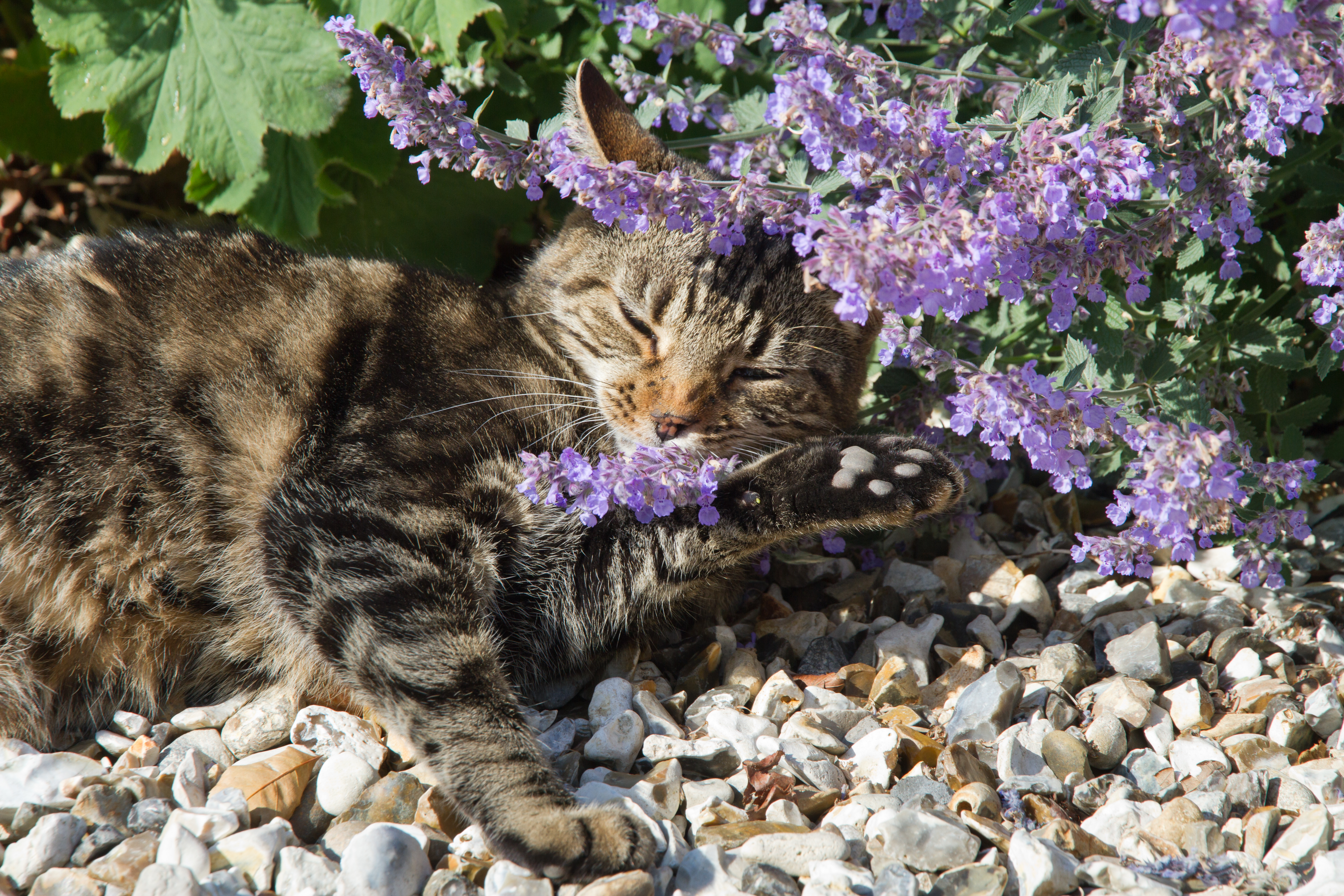Forget catnip, it's all about catmint
Nepeta, the highly aromatic and pretty perennial beloved of so many country gardens, may be your feline’s favourite fix, but we should be wary of its root, warns Deborah Nicholls-Lee


Rubbing, rolling, pawing and grabbing — the apparent euphoria aroused by nepeta or catmint can make even the most superior feline go gaga. It’s thought that the Ancient Egyptians — well-documented ailurophiles — were among the first to give catmint to their cats. The Romans, as far as we know, kept it mostly for themselves, taking it as pain relief and flavouring their food with it. It was used as an amulet to ward off evil spirits in the Middle Ages, whereas modern-day occultists believe it can foster friendship when rubbed on the palms.
The plant’s antiseptic and analgesic properties have seen it used in a variety of ways over the centuries. Poultices were applied to the gums to ease toothache, to the sore breasts of nursing mothers and even down below to tackle the discomfort of piles. It’s also thought that catmint tea can alleviate stomach aches and reduce fevers. Culinary uses for its serrated leaves abound, from marinades and salads to a meat rub that flavours and tenderises. The leaves and flowers (fresh or dried) are still drunk in tea today for the herb’s calming qualities, antioxidants and vitamin C. Beware the roots, however, which may have the reverse effect. There’s an old saying that ‘if the root be chewed, it will make the quietest person fierce and quarrelsome’. According to folklore, hangmen made use of this peculiar quality to gain the guts needed to go about their gruesome work.
However, for most of us, catmint is for cats, yet their response to it can vary enormously. ‘Some might sniff it, lick it or start chewing it,’ says Sussex-based veterinary nurse and cat behaviourist Zoe Blake. Others ‘will present as euphoric’, ‘almost have a sexual attraction [to it]’, ‘roll around and rub themselves’ on the plant or purr persistently.

Temperament, as well as genetics, plays a role. ‘You might have a three-cat household and they’ll all react differently,’ continues Blake. ‘Calm cats are often the ones that will get excited. Nervous cats are often the ones that become relaxed. It does the opposite of what you’d expect.’ It’s the cat’s ‘incredible sense of smell’ that makes catmint so intriguing to them. As they take in the scent of catmint, ‘their brain is working overtime,’ she notes and the effect can last up to two hours. Although about 70% – 80% of cats will react to catmint (even big cats can’t resist it) it is kittens, Blake explains, that ‘often don’t have any reaction’.
Owners may find catmint a useful training tool, she suggests. A cat that is scratching furniture, for example, can be guided to a new scratch post by scenting it with catmint. For cats that find it calming, placing catmint in their box when they are travelling in the car can help relieve anxiety on trips to the vet. It’s a chemical in catmint called nepetalactone that triggers these odd responses in cats, says Benjamin Lichman, a biochemist and senior lecturer at the University of York, who is undertaking research into how catmint developed this unusual property. ‘It releases endorphins in cats that gives them this pleasure and encourages them to anoint themselves with the herb. That transfers nepetalactone onto their fur, which is thought to provide insect repellent properties.’ These cunning creatures, he summarises, ‘have evolved to self-medicate’ from catmint. In fact, according to a 2001 study by Iowa State University, nepetalactone is 10 times more powerful than DEET and can even repel cockroaches.

Catmint? It's the cat's meow.
Fortunately for us, the benefits are not confined to felines. Dr Lichman is part of a project partnering with the US to develop a product for humans using nepetalactone that, he says, offers an alternative to DEET that is ‘a more environmentally friendly biological source of insect repellent’. Gardeners are also tapping into catmint’s protective powers. ‘It’s these chemical properties that have encouraged nepeta to be grown as a companion plant, especially with roses,’ continues Dr Lichman.
If catmint doesn’t tickle your whiskers, there are other non-mints that have a similar effect on cats and will also deter insects, such as valerian (Valeriana officinalis), native to the UK, as well as silver vine (Actinidia polygama) from East Asia. Simon Poole is an associate professor at the University of Chester and the founder of Mintopia, an online nursery and National Plant Collection featuring 198 mint varieties. Although his collection focuses on mentha, he has grown catmint for years and with about 290 recognised species of catmint to choose from, is not short of inspiration.
Exquisite houses, the beauty of Nature, and how to get the most from your life, straight to your inbox.
‘It’s not a plant that’s super fussy,’ he reveals and it also tolerates most soils. Catmint does best in the ground, but his recipe for success in pots is ‘two spades of loamy compost to one part horticultural sand’ and ‘chuck in a handful of grit’. Catmint, he continues, is ‘quite a promiscuous plant’ that needs no fertiliser and ‘will thrive in nooks and crannies’. Versatile and loved by pollinators, it works well in borders and will even become ‘a nice bushy stock’ if you let it. ‘I grow it mostly in hanging baskets because I like the way it droops,’ he enthuses. ‘It’s a great filler and it will find light.’
Poole also makes tea with it, perusing the myriad mint varieties in his garden to find the perfect blend. ‘It can be a bit astringent at times on its own because it’s got that lemonyness about it, so I tend to mix it with other things, like Japanese mint (Mentha arvensis var. piperascens).’ Some gardeners advise sticking to sterile hybrids as the sharp-elbowed catmint can crowd out other plants. This issue may well be exacerbated if ecstatic cats get their paws on the plants. ‘They are quite good at spreading the pollen around,’ points out Blake. ‘If they’re rolling all over it in the garden, you’ll probably end up with a bigger patch than you initially grew.’
Deborah Nicholls-Lee is a freelance feature writer who swapped a career in secondary education for journalism during a 14-year stint in Amsterdam. There, she wrote travel stories for The Times, The Guardian and The Independent; created commercial copy; and produced features on culture and society for a national news site. Now back in the British countryside, she is a regular contributor for BBC Culture, Sussex Life Magazine, and, of course, Country Life, in whose pages she shares her enthusiasm for Nature, history and art.
